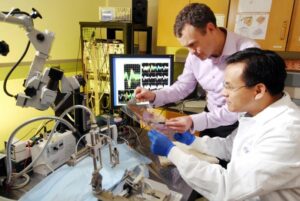Top 20 Electronics & Telecommunication Engineer Fresher Interview Questions
Table of Contents
Top 20 Electronics & Telecommunication Engineer Fresher Interview Questions
1. Can you explain the basic difference between electronics and telecommunication?
Example – “Electronics deals with the study of electrical circuits and components, while telecommunication involves the transmission of information over long distances. Electronics is the foundation of telecommunication as it provides the necessary technology for signal processing and amplification.”
2. What is Ohm’s Law, and how is it relevant in electronics?
Example – “Ohm’s Law states that the current passing through a conductor is directly proportional to the voltage across it and inversely proportional to its resistance (I = V/R). It’s crucial in electronics because it helps in understanding and calculating the relationship between voltage, current, and resistance in electrical circuits.”
3. Explain the concept of a diode?
Example – “A diode is a two-terminal semiconductor device that allows the flow of current in one direction only. It acts as a one-way valve for electrical current, making it fundamental for rectification and signal modulation in electronics.”
4. What is the purpose of an operational amplifier (op-amp) in electronics?
Example – “An operational amplifier is a versatile component used for amplifying and processing signals. It’s commonly used to amplify weak signals, perform mathematical operations, and create analog filters.”
5. Describe the role of a microcontroller in electronic devices?
Example – “A microcontroller is a small computing device integrated into electronic systems to control various functions. It manages tasks such as data processing, memory storage, and interfacing with external sensors or devices.”
6. What is a printed circuit board (PCB), and why is it essential in electronics?
Example – “A PCB is a board with printed conductive tracks used to connect electronic components. It provides a compact, organized, and reliable way to assemble and interconnect electronic circuits, making it crucial in modern electronics.”
7. How does analog communication differ from digital communication?
Example – “Analog communication transmits continuous signals, whereas digital communication uses discrete signals (bits). Digital communication is more robust against noise and distortion, making it preferred for modern telecommunication systems.”
8. Explain the concept of modulation in telecommunication?
Example – “Modulation is the process of varying a carrier signal’s properties (e.g., amplitude, frequency, or phase) to transmit information. It allows the transmission of analog or digital data over long distances.”
9. What is the significance of the Nyquist theorem in digital communication?
Example – “The Nyquist theorem states that to accurately reproduce a signal, the sampling rate must be at least twice the signal’s maximum frequency. It’s crucial in digital communication to prevent aliasing and signal distortion during sampling and reconstruction.”
10. What is the difference between a router and a modem in a network setup?
Example – “A modem (modulator-demodulator) converts digital data from a computer into analog signals for transmission over telephone lines, while a router directs data packets between devices within a local area network (LAN) and the wider internet.”
11. Can you explain the concept of latency in network communication?
Example – “Latency is the delay between sending and receiving data packets in a network. It can be caused by various factors, including network congestion, processing time, and physical distance, and it’s crucial to minimize it for efficient communication.”
12. What are the advantages of using fiber optics in telecommunication?
Example – “Fiber optics offer high-speed data transmission, low signal loss, and immunity to electromagnetic interference. They are essential for long-distance communication and high-speed internet connections.”
13. Describe the difference between half-duplex and full-duplex communication.
Example – “In half-duplex communication, data can be transmitted in both directions, but not simultaneously (like a walkie-talkie). In full-duplex communication, data can be transmitted simultaneously in both directions (like a phone call).”
14. What is a signal-to-noise ratio (SNR), and why is it important in communication systems?
Example – “SNR measures the ratio of the signal strength to the noise level in a communication channel. A higher SNR indicates better signal quality and less distortion, which is crucial for reliable data transmission.”
15. Explain the concept of multiplexing in telecommunication.
Example – “Multiplexing is the technique of combining multiple signals into a single transmission channel. It allows efficient use of bandwidth and is essential in various communication systems, including telephone and data networks.”
16. How do you handle electromagnetic interference (EMI) in electronic designs?
Example – “EMI can be reduced by shielding sensitive components, using twisted-pair cables, and adding EMI filters. Proper grounding and layout design are also essential to minimize interference.”
17. What programming languages or software tools are you familiar with for electronics and telecommunication applications?
Example – “Mention any programming languages (e.g., C++, Python), simulation tools (e.g., MATLAB, Simulink), and design software (e.g., Altium, Cadence) you are proficient in.”
18. Can you discuss a project or internship experience related to electronics or telecommunication engineering?
Example – “Share details of a relevant project you’ve worked on, highlighting your contributions, challenges faced, and the outcomes achieved.”
19. How do you stay updated with the latest advancements in electronics and telecommunication?
Example – “Mention your strategies for continuous learning, such as reading research papers, following industry news, attending workshops, or participating in online courses.”
20. What are your career goals in electronics and telecommunication engineering?
Example – “Discuss your long-term aspirations in the field, whether it’s specializing in a particular area, pursuing advanced degrees, or contributing to innovative technologies.”




